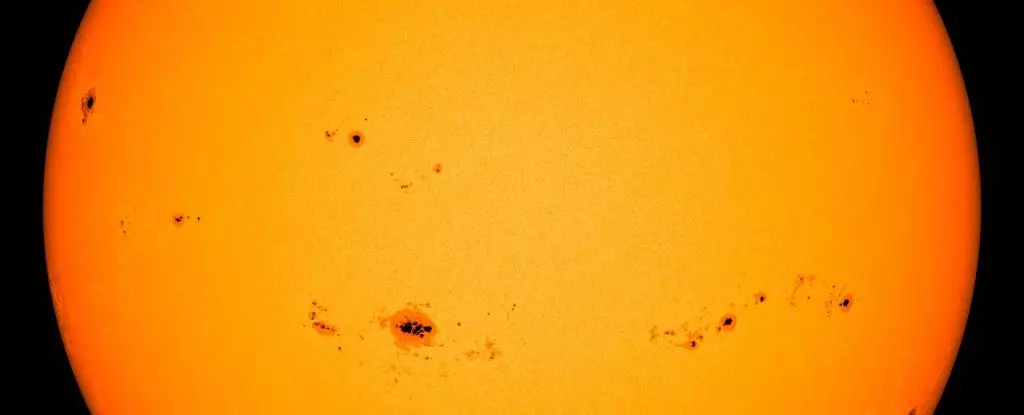For those observing the cosmic drama unfolding in our sky, the news from NASA, the National Oceanic and Atmospheric Administration (NOAA), and the Solar Cycle Prediction Panel is both exciting and ominous. We are now in the throes of solar maximum, the climactic peak of the Sun’s 11-year cycle. This stage signifies a season of heightened solar activity characterized by an increase in sunspots, solar flares, and coronal mass ejections (CMEs). As these phenomena manifest, they serve as windows into the complex dynamics of our star and the solar system at large.
Solar maximum is not merely a momentary spectacle; it is followed by a gradual decline into solar minimum, marking a quieter phase within the solar cycle. This transition is notable not just for its dramatic celestial displays but for what it reveals about the fundamental workings of the Sun. Unfortunately, the unpredictability of when maximum activity will peak remains a challenging aspect that astronomers must grapple with. Despite our advancements in astrophysics, the precise timing and intensity of these solar oscillations elude even the most sophisticated predictive models.
The Mysteries Beneath the Surface
The Sun is a constant presence in our lives, a source of energy and warmth. However, it is a dynamic entity undergoing substantial changes. The inquiry into what generates these cycles, particularly the solar dynamo responsible for the Sun’s magnetic activity, is a complex scientific dilemma. Michael Wheatland, a solar astrophysicist at the University of Sydney, noted the confusion surrounding these cycles. The conditions within the Sun’s interior that lead to sunspot formation remain poorly understood, leaving astronomers at a crossroads in solar research.
While each solar cycle spans roughly 11 years, significant variations occur in their duration and strength; some cycles may last longer than others or exhibit different intensities. Such discrepancies challenge the scientific community to improve its understanding of solar behavior. The importance of tracking solar cycles is underscored by scientists and meteorologists who rely on measurable phenomena to gauge the Sun’s progression. Sunspots, the dark patches on the solar surface, allow researchers to quantify solar activity and predict the solar cycle’s phases.
Solar activity manifests in various forms that significantly affect not only space weather but also the technology-dependent lifestyle of Earth’s inhabitants. The eruption of solar flares and CMEs, while visually spectacular, can disrupt communication systems, power grids, and navigation satellites. The energy released during a solar flare can lead to radio blackouts, disrupting our daily communications. More daunting are the CMEs, which, when they collide with Earth’s magnetic field, initiate geomagnetic storms capable of generating surges in electrical systems and inducing harm to satellites.
Yet, amidst this chaos lies beauty. Geomagnetic storms contribute to the ethereal dance of auroras, painting the night sky with hues of green, pink, and violet. These awe-inspiring displays are a reminder of the Sun’s power and its ability to create both turmoil and beauty. Interestingly, this year has seen a pronounced increase in aurora sightings, making it a thrilling time for observers of the natural world.
While this solar cycle has outperformed initial predictions from NASA and NOAA, it has not reached historical extremes. The most impactful flare to date scored a high rating of X9.0 on October 4, contributing to the ongoing discussion among scientists eager to decipher the implications of such activity. This cycle, while significantly stronger than some forecasts suggested, still lies within the bounds of typical solar behavior.
Future analysis of this cycle may yield vital insights into solar predictions and encourage discussions about improving existing models. The unexpected intensity of this solar cycle raises important questions: What can it teach us about the solar dynamo? How might we refine our methods to anticipate future solar activity? The veracity of these inquiries holds colossal significance for not just astrophysics but also for the technology that underpins our modern society.
As we traverse this period of solar maximum, Earth’s inhabitants must remain vigilant and informed. The cosmic journey of our Sun acts as both a formidable force and a breathtaking sight. With our understanding of solar dynamics evolving, the potential for enhanced predictive capabilities looms on the horizon. It is critical that we embrace the challenge presented by our Sun, preparing ourselves for not just the storms but also the profound revelations we may uncover along the way. The intricate dance of astrophysics promises not only trials but a deeper comprehension of our magnificent celestial neighbor.

